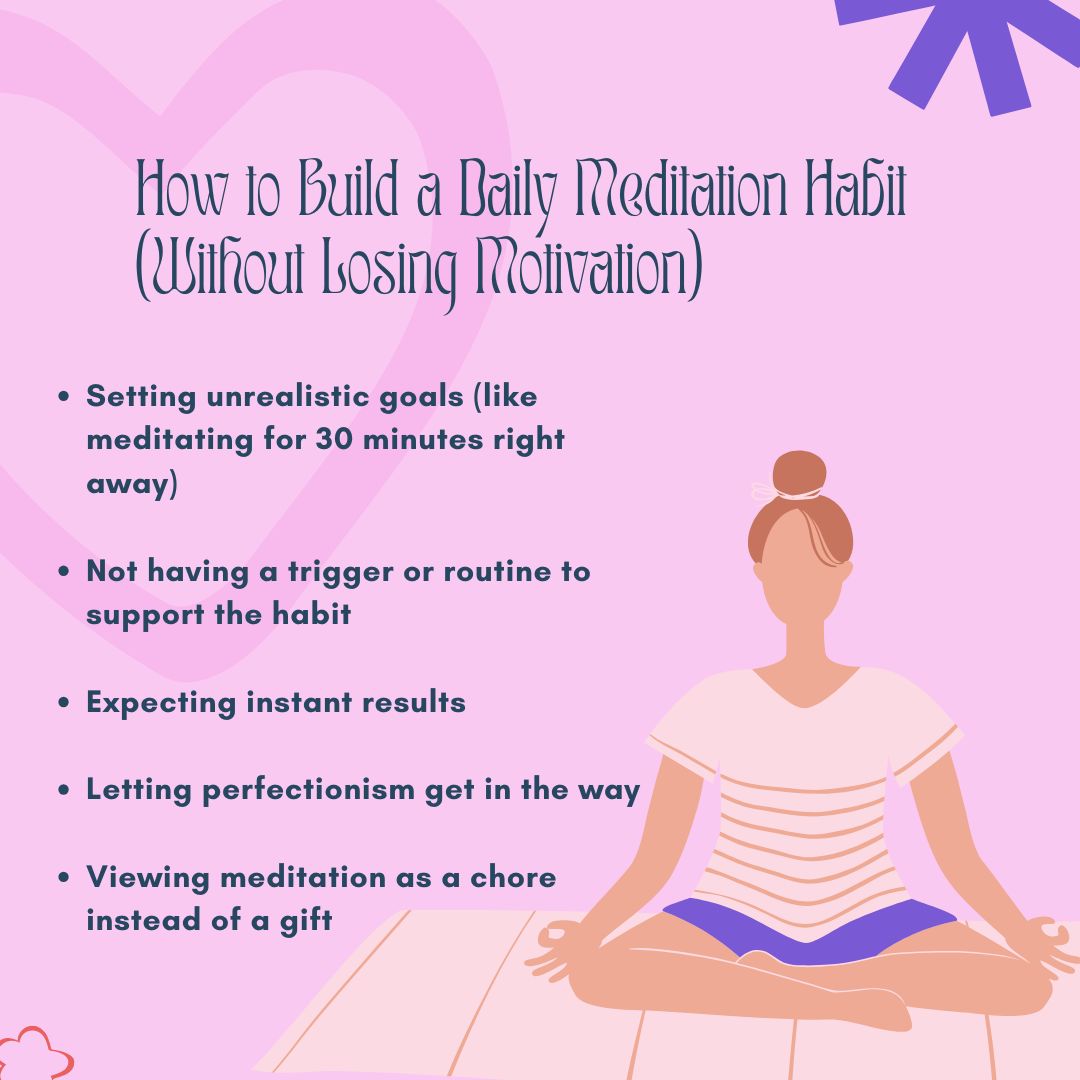Introduction: Why Meditation Matters Now More Than Ever
In a world where life is moving faster than ever, carving out time for peace, focus, and presence has become essential. Meditation offers a proven path toward calm and clarity—boosting mental wellness, reducing anxiety, improving sleep, and sharpening focus. But while many people start with the best intentions, building a consistent meditation habit can be surprisingly difficult.
If you’ve struggled with motivation or fallen off your meditation routine, you’re far from alone. The good news? You don’t need to meditate for 30 minutes a day or have perfect discipline to see results. With a few simple adjustments, you can create a daily meditation practice that’s sustainable, enjoyable, and impactful.
In this guide, you’ll learn eight proven steps to develop a meditation habit that fits your lifestyle—so you can enjoy lasting calm and clarity in your everyday life.
Why People Struggle to Stay Consistent with Meditation
Before we dive into the how, it’s important to understand the why behind the struggle. Many people give up on meditation early because they:
-
Set unrealistic goals (e.g., trying 30 minutes daily from day one)
-
Don’t link meditation to any existing routine
-
Expect instant results
-
Let perfectionism stall progress
-
View meditation as another “task” instead of a mental refresh
To build a lasting meditation habit, it has to feel simple, easy to begin, and rewarding to return to—even on your busiest days.
Step 1: Start with Just 2–5 Minutes a Day
One of the biggest myths about meditation is that it needs to be long to be effective. In reality, just 2 to 5 minutes a day can create noticeable benefits. Starting small removes resistance and makes it easier to stay consistent.
💡 Example:
Instead of saying:
“I’ll meditate for 30 minutes every morning.”
Try:
“I’ll meditate for 2 minutes after I brush my teeth.”
This lowers the mental barrier and helps create early momentum.
Step 2: Anchor Meditation to an Existing Habit
Linking meditation to a habit you already do every day is one of the most powerful ways to build consistency. This is called habit stacking—a simple way to embed new routines into your current lifestyle.
🧩 Habit Stack Formula:
After I [existing habit], I will meditate for [X] minutes.
✅ Effective Anchors:
-
After brushing your teeth
-
Before drinking your morning coffee
-
Right after taking a shower
-
Before you get into bed
When meditation becomes part of something you’re already doing, it’s easier to remember—and harder to skip.
Step 3: Use Visual Cues and Reminders
Willpower fades, but environmental cues can keep you on track. Create a physical or digital space that gently reminds you of your intention.
📌 Try This:
-
Set a daily alarm labeled “Just Breathe”
-
Place your meditation cushion or yoga mat in plain view
-
Stick a post-it note on your mirror or laptop
-
Use lock screen wallpapers with calming affirmations
These micro-reminders reduce friction and make meditation part of your daily flow.
Step 4: Use Guided Meditation Apps (Even for 3 Minutes)
If you’re struggling to meditate solo, don’t worry—guided meditation apps can help build your focus and provide structure.
📱 Top Meditation Apps for Beginners:
-
Insight Timer – Free, with thousands of short meditations
-
Headspace – Offers themed meditations and beginner programs
-
Calm – Excellent for stress relief and deep sleep
-
Simple Habit – Designed for quick, on-the-go sessions
-
Balance – Personalized daily meditation plans
Most of these apps offer sessions under 10 minutes, so there’s no pressure to commit to long stretches.
Step 5: Track Your Meditation Streak
Tracking progress—no matter how small—can dramatically boost motivation. It also helps you notice patterns and recognize your wins.
📊 Ways to Track:
-
Use a habit tracker app (like Habitica, Streaks, or Loop)
-
Mark each successful day on a calendar with an ✖️
-
Write a short note in a meditation journal (even just one word like “calm”)
💡 Rule of Thumb:
Never miss two days in a row. One off-day is okay—just return with kindness the next day.
Step 6: Create a Pre-Meditation Ritual
Rituals signal to your brain that it’s time to shift from “doing” into “being.” Even a short, simple ritual can prepare your body and mind for stillness.
🕯️ Ritual Ideas:
-
Light a candle or incense stick
-
Brew calming herbal tea
-
Take 3 deep breaths
-
Put on calming music or nature sounds
-
Dim the lights
These small rituals make the practice feel intentional and sacred, rather than like a chore.
Step 7: Be Gentle with Yourself on Off Days
Meditation is not a discipline of perfection—it’s a practice in presence and self-compassion. Missing a session doesn’t mean you’ve failed.
❤️ Self-Compassion Reminders:
-
Skipping a day doesn’t erase your progress
-
Every breath is a fresh start
-
Your effort matters more than duration
Even seasoned meditators have off days. What matters is that you keep coming back—without judgment.
Step 8: Find the Best Time That Works for You
There’s no single best time to meditate. The best time is whatever works for your body, your energy levels, and your routine.
🕐 Time Options:
-
Morning: Sets a calm tone for the day
-
Afternoon: Helps release midday stress
-
Evening: Prepares your body and mind for restful sleep
-
Split Practice: Try 2 minutes in the morning and 3 minutes at night
Explore different times and stick with what feels easiest and most enjoyable for you.
Final Thoughts: Meditation Is a Gift, Not a Task
You don’t need silence, a yoga mat, or hours of time. You just need a moment. One conscious breath. One pause in the rush of your day.
By starting small, tying meditation to routines, using reminders, and letting go of perfectionism, you’ll build a daily meditation habit that lasts—and changes your life from the inside out.
💬 Remember: Even a single deep breath in stillness is a victory.
✨ For more wellness tips, mindful practices, and daily fitness habits, visit Fit Forevers—your go-to guide for a healthier, calmer, and more focused lifestyle.

